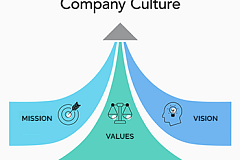 The working world is changing – rapidly – and no amount of “positive thinking” can stop people from worrying about their jobs being replaced by artificial intelligence (AI), robotics, or low-wage workers in China and Mexico. As of 2017, Canada had approximately 2.8 million self-employed workers, and small businesses supplied 75 percent of all private jobs in the country.
The working world is changing – rapidly – and no amount of “positive thinking” can stop people from worrying about their jobs being replaced by artificial intelligence (AI), robotics, or low-wage workers in China and Mexico. As of 2017, Canada had approximately 2.8 million self-employed workers, and small businesses supplied 75 percent of all private jobs in the country.
Whether you consider yourself a freelancer, an entrepreneur, a small business or a start-up, the principle is the same and you need certain qualities to be able to go for it.
What Being an Entrepreneur Means
An entrepreneur is an individual or a small group of people who start a business from scratch. Usually, they’re operating on their own dime and begin without any branding, customers, staff, or products.
Entrepreneurs take on all the decision-making and the risks of the business venture and earn all the profits for themselves. Some elect to keep money in the company and pay themselves a fixed amount, while others draw out all surplus funds for their personal use. [quotesright]The owner is solely responsible for all profit and losses incurred. [/quotesright]
The Gig Economy
The rising gig economy has bolstered the ranks of Canadian entrepreneurs substantially over the past few years. That’s because being a freelancer or “gig worker” is essentially a form of entrepreneurship, and it’s becoming the most popular method of working in the 21st century.
Pushed out by the transition to technology, the rise of artificial intelligence and the automation of, well, everything, Canadians are digging deep to find the pioneering spirit that served their forefathers so well in their country’s early days.
[sidebar]
GOING IT ALONE
By 2020:
- 55 percent of Canadians predicted to be self-employed.
- 35 percent of U.S. workers predicted to be self employed.
[/sidebar]
Going it alone has become so prevalent that Intuit predicted last year that 45 percent of Canadians would be self-employed by 2020. Down south, 55 million Americans are currently working as freelancers, which comes out at 34 percent of the U.S. workforce.
The Link with Entrepreneurship
So how does the gig economy tie in with entrepreneurship? Simply put, the gig economy has created a new breed of worker that wants the freedom and flexibility of working for their own objectives.
Even though 80 percent of employees say they would like to freelance, most of them haven’t taken the plunge yet because they don’t have the courage to leave behind the consistency in income, structure, and support.
It takes a special type of person to do that, one with entrepreneurial spirit and the confidence in themselves to take the risk.
Successes and Failures
Canadians are tough, and as a result they don’t give up easily. In fact, Canada is second only to the U.S. in its level of entrepreneurial activity, and beats most of the G7 countries and the rest of the developed world.
Of almost 1.1 million Canadian SMEs, of which 55 percent have fewer than 4 employees, 96 percent survive for a year, 85 percent for three years and 70 percent survive for five years. That’s not too bad a record, but there are still in excess of 7,000 that go bankrupt each year.
The Secrets to Successful Entrepreneurship
Since entrepreneurship conclusively seems to be the future of work for a vast number of people, it’s essential that small business operators get to grips with the secrets to successful operation as fast as possible.
[quotes]Here’s where employing a business coach can really make a difference and boost your chances of success from “iffy” to “dead certain.” [/quotes] The main areas where coaches suggest business owners focus their attention are:
Strategy. One of the first requirements for starting a company is to develop a business plan that is intended to guide your activities to achieve ongoing growth. [quotesright]However, many business coaches will tell you that it’s more important to have a strategy before building your plan, because without it you could find your plan is on the wrong track. [/quotesright]
Devise the high-level strategy you’ll use to grow your business in a particular market and determine the deliverables you’ll need to achieve before you can say the strategy was effective. This could include the number of employees you’ll have, the number of customers, the value of your revenue stream, or multiple other factors.
Planning. When you have a strategy in place, the business plan outlines the day-to-day actions you take to realize it. Perhaps you need to add a new product line to attract higher paying customers, or perhaps you should make changes to an existing service to provide a more desirable option for local clients.
The business plan should be broken up into short term (next 6 months), medium term (next 2 years) and long term (5 to 10 years), and outline precisely what objectives you want to achieve during each time frame and how you intend to do so.
Recruiting Talented Employees. Since SMEs in Canada create around 100,000 jobs each year, entrepreneurship seems to be a powerful component of the working environment. [quotes]And while it’s as essential that small companies attract the right talent as it is for large ones, there are risks prevalent in entrepreneurs. [/quotes]
Often, they don’t have much experience employing workers, let alone a qualified HR person, and this leaves them open to making mistakes that could end in lawsuits.
Managing Company Culture. Cultures develop according to the people driving them, and if this isn’t the business owner, it’s going to default to the strongest employee in the firm. That might not be quite the culture you want, so it’s important to foster an ideal environment from the get-go.
Culture isn’t just about writing down your values or supplying good coffee for the staff, it includes day-to-day attitudes, behaviors and conversations. [quotesright]Once a culture establishes itself, it’s hard to change, and if it’s toxic it can affect every molecule of the business. [/quotesright]
The Foreseeable Future
As intimidating as the future of entrepreneurship looks, it’s still the most promising option for the Canadian economy for the foreseeable future. So, pick yourself up, dust yourself off and start making your SME into the powerhouse you want it to be.
Resources:
- https://www.collegepropotential.com/hub/posts/entrepreneurship-and-the-changing-future-of-work-22834394
- https://www150.statcan.gc.ca/t1/tbl1/en/tv.action?pid=1410002701
- https://business.financialpost.com/technology/personal-tech/intuit-says-45-of-canadians-will-be-self-employed-by-2020-releases-new-app-to-help-with-finances
- https://www.forbes.com/sites/brianscudamore/2018/05/09/how-the-gig-economy-is-fueling-a-new-type-of-entrepreneur/#1bc35dae6e11
- https://www.bdc.ca/en/articles-tools/business-strategy-planning/manage-business/pages/10-things-didnt-know-canadian-sme.aspx
- https://smallbusiness.co.uk/how-poor-company-culture-is-affecting-smes-2544200/
- https://montrealgazette.com/news/local-news/members-of-ethnic-groups-top-the-ranks-of-canadas-self-employed
- https://www.ic.gc.ca/eic/site/061.nsf/eng/h_03018.html#point2-2













